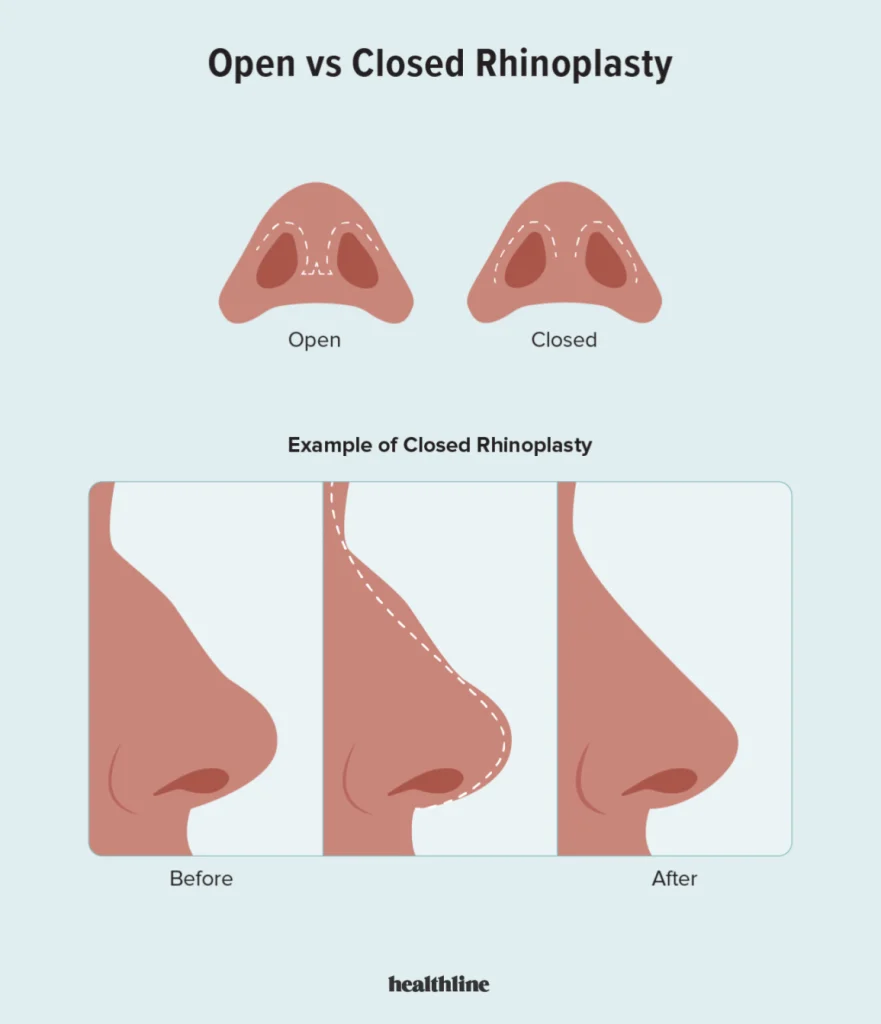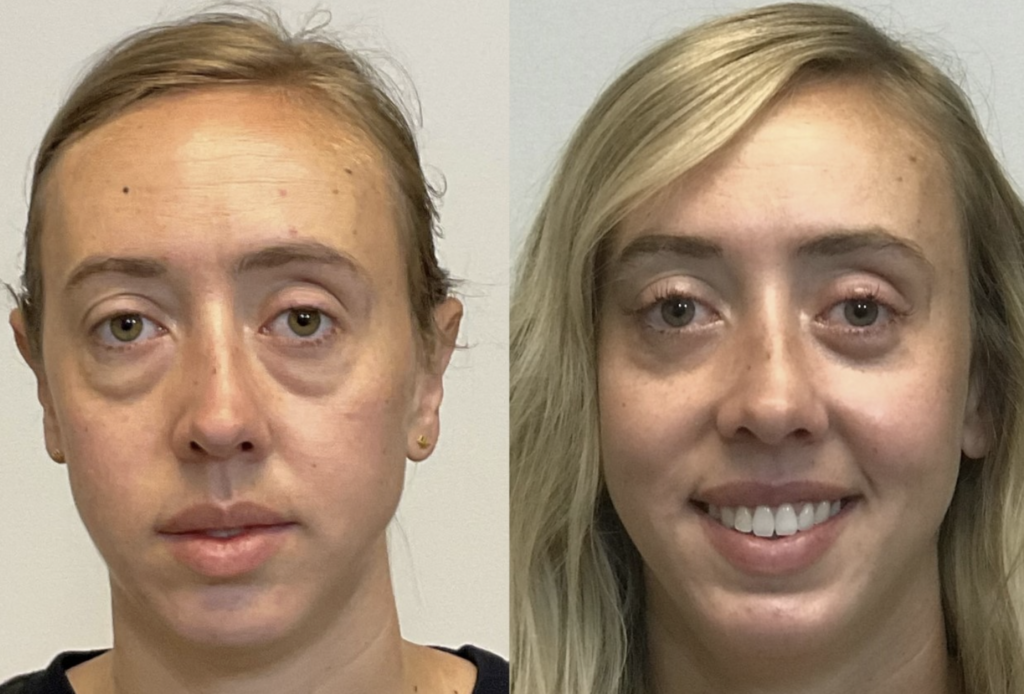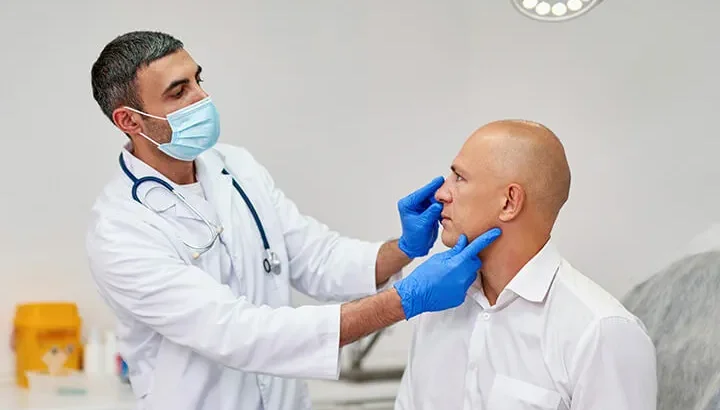Contents;
What Is Closed Rhinoplasty?

Closed rhinoplasty, also known as endonasal rhinoplasty, is a surgical procedure performed to reshape or enhance the appearance of the nose. Unlike open rhinoplasty, where an external incision is made on the columella (the strip of skin between the nostrils), closed rhinoplasty involves incisions made inside the nostrils. This technique offers several advantages, including minimal scarring, shorter recovery time, and reduced risk of certain complications.
In closed rhinoplasty, the surgeon accesses the nasal structures through the nostril openings. This approach eliminates the need for an external incision, resulting in no visible scarring. The surgeon carefully manipulates the nasal tissues, cartilage, and bone to achieve the desired aesthetic or functional outcome. The closed technique is often suitable for patients who require minor alterations to the shape or size of their nose.
Some common reasons why individuals opt for closed rhinoplasty include correcting a deviated septum, refining the nasal tip, narrowing the nasal bridge, or improving the overall symmetry of the nose. However, it’s important to note that closed rhinoplasty may not be suitable for all patients. Complex cases or those requiring significant reshaping may be better candidates for open rhinoplasty.
Advantages Of Closed Rhinoplasty

Closed rhinoplasty is a surgical procedure that is used to reshape or resize the nose. Unlike open rhinoplasty, it involves making incisions inside the nostrils, which eliminates the need for external scarring. This technique is preferred by many patients due to its numerous advantages.
One of the major advantages of closed rhinoplasty is the absence of visible scarring. Since the incisions are made internally, there are no external scars that can be seen. This is a significant benefit for individuals who are concerned about the aesthetic appearance of their nose post-surgery.
In addition, closed rhinoplasty typically results in less swelling and a quicker recovery time compared to open rhinoplasty. The procedure is less invasive and does not involve separating the nasal skin from the underlying structures. As a result, patients generally experience less bruising and discomfort after surgery, leading to a faster healing process.
Furthermore, closed rhinoplasty is often associated with shorter operating times. The procedure can be performed more efficiently as there is no need to create an external incision. This means that less time is spent in the operating room, which can result in lower costs and reduced risks associated with anesthesia.
Limitations Of Closed Rhinoplasty

When considering a rhinoplasty procedure, it is important to understand the limitations that come with closed rhinoplasty. Closed rhinoplasty, also known as endonasal rhinoplasty, is a surgical technique used to reshape the nose without making any visible external incisions. While closed rhinoplasty has its advantages, it is not suitable for everyone and may have some limitations that patients should be aware of.
One of the main limitations of closed rhinoplasty is the limited access it provides to the underlying nasal structures. Unlike open rhinoplasty, which involves making an incision on the columella, closed rhinoplasty only allows access through the nostrils. This restricted access can make it more challenging for the surgeon to visualize and manipulate the nasal structures, particularly in complex cases. The surgeon’s ability to accurately assess and modify the nasal framework may be limited, potentially compromising the final results.
Another limitation of closed rhinoplasty is the inability to address certain aesthetic and functional issues. Closed rhinoplasty is best suited for patients who require minor modifications to the nasal tip or small humps on the bridge of the nose. However, it may not be the ideal approach for patients with severe nasal deformities or complex structural issues, such as deviated septum or significant asymmetry. In such cases, open rhinoplasty, which offers greater visibility and access to the nasal structures, may be a more suitable option.
- One limitation of closed rhinoplasty is limited access to underlying nasal structures.
- Another limitation is its inability to address complex structural issues.
- Open rhinoplasty may be a more suitable option for patients with severe nasal deformities or significant asymmetry.
It is important for individuals considering closed rhinoplasty to consult with a highly skilled and experienced surgeon. The surgeon’s expertise and understanding of the limitations of closed rhinoplasty can help determine whether this technique is suitable for achieving the desired results. During the consultation, the surgeon will evaluate the patient’s nasal anatomy, discuss their goals and expectations, and recommend the most appropriate surgical approach.
| Advantages | Limitations |
|---|---|
| ✓ No visible external scars | ✕ Limited access to nasal structures |
| ✓ Shorter recovery time | ✕ Inability to address complex structural issues |
| ✓ Less postoperative swelling and bruising | ✕ Not suitable for all patients |
In conclusion, while closed rhinoplasty can be an effective option for certain patients, it does have its limitations. The restricted access to nasal structures and the inability to address complex structural issues may limit the surgeon’s ability to achieve optimal results in certain cases. It is crucial for patients to have a thorough consultation with a qualified surgeon to determine the most suitable approach for their specific needs and goals. By understanding the limitations and discussing them with the surgeon, patients can make well-informed decisions about their rhinoplasty procedure.
Procedure Steps Of Closed Rhinoplasty

When considering rhinoplasty, there are two main techniques available – open rhinoplasty and closed rhinoplasty. In this blog post, we will focus on the procedure steps involved in closed rhinoplasty. Closed rhinoplasty, also known as endonasal rhinoplasty, is a technique where incisions are made only inside the nostrils, without any external incisions. This technique offers several advantages such as minimal scarring, decreased swelling, and a quicker recovery time.
In closed rhinoplasty, the first step is the administration of anesthesia. The surgeon will choose between general anesthesia or local anesthesia with sedation, depending on the patient’s needs and preferences. Once the patient is comfortably numbed or asleep, the surgeon will proceed to the next step.
The second step involves making incisions inside the nostrils. These incisions are carefully placed to allow access to the underlying nasal structures. The surgeon uses specialized instruments to lift and separate the nasal skin from the underlying bone and cartilage. By doing so, they gain a clear view of the nasal anatomy and can proceed with the reshaping process.
Expected Results And Recovery Time

In a closed rhinoplasty procedure, also known as endonasal rhinoplasty, the surgeon makes incisions inside the nostrils to access and reshape the nasal structure. This technique offers several advantages such as minimal scarring, faster recovery, and less postoperative swelling compared to an open rhinoplasty procedure. However, patients should be aware of the expected results and the recovery time associated with closed rhinoplasty.
After a closed rhinoplasty surgery, patients can expect a more refined and symmetric nasal appearance. The nasal tip can be reshaped to achieve better projection and contour, while any humps or bumps on the bridge of the nose can be smoothed out. The overall goal of the procedure is to improve facial harmony and balance by enhancing the natural contours of the nose. However, it is important to have realistic expectations as the final results may take several weeks or even months to fully develop.
When it comes to the recovery time, closed rhinoplasty generally offers a quicker healing process compared to an open rhinoplasty. Since there are no external incisions or visible scars, patients often experience less bruising and swelling. Within the first week after surgery, most of the swelling will start to subside, and any residual bruising can usually be easily concealed with makeup. However, it is important to note that individual healing times may vary, and it may take several months for the nasal tissues to fully heal and for the final results to become apparent.
Comparing Closed Rhinoplasty With Open Rhinoplasty

Rhinoplasty, commonly known as a nose job, is a surgical procedure performed to reshape, resize, or improve the overall appearance of the nose. There are two main techniques used in rhinoplasty: closed rhinoplasty and open rhinoplasty. In this blog post, we will focus on comparing these two approaches and discussing their pros and cons.
Closed rhinoplasty is a technique where all incisions are made inside the nose. This means that there are no visible external scars after the surgery. The surgeon will make small incisions inside the nostrils to access the nasal structures. This technique offers several advantages. First, since the incisions are hidden, there is no risk of visible scarring. Second, the recovery time is usually shorter compared to open rhinoplasty. Additionally, closed rhinoplasty often results in less swelling and bruising, leading to a quicker and more comfortable recovery period.
Open rhinoplasty, on the other hand, involves creating an additional incision on the columella, the narrow strip of tissue between the nostrils. This external incision allows the surgeon to lift the skin and access the nasal structures more easily. While open rhinoplasty provides better visibility and access for the surgeon, it does leave a small scar on the columella. However, this scar is usually well-hidden and becomes less noticeable over time.
When comparing closed rhinoplasty with open rhinoplasty, it’s important to consider the specific goals and needs of each patient. Closed rhinoplasty is often preferred for minor nasal corrections, such as addressing a small hump or refining the tip. Since there are fewer incisions involved, the surgical time is usually shorter, and the procedure can be less invasive. On the other hand, open rhinoplasty is recommended for more complex cases that require extensive reshaping and reconstruction, especially for patients who have significant nasal deformities or breathing issues. The additional visibility provided by open rhinoplasty allows the surgeon to make precise modifications to achieve the desired results.
| Comparison | Closed Rhinoplasty | Open Rhinoplasty |
|---|---|---|
| Incisions | Inside the nose, no visible scars | Inside the nose and additional incision on the columella |
| Visibility | Reduced visibility for the surgeon | Enhanced visibility for the surgeon |
| Recovery Time | Shorter recovery time with less swelling and bruising | Longer recovery time with more swelling and bruising |
| Recommended Cases | Minor nasal corrections | Complex cases requiring extensive reshaping |
In conclusion, both closed and open rhinoplasty techniques have their own advantages and limitations. Closed rhinoplasty offers the benefits of no visible scarring, shorter recovery time, and reduced swelling. On the other hand, open rhinoplasty provides enhanced visibility for the surgeon and is more suitable for complex cases. Choosing the right technique depends on the individual patient’s needs, nasal anatomy, and desired results. It is essential to consult with a qualified and experienced plastic surgeon who can determine the most appropriate technique for each specific case.
Choosing The Right Surgeon For Closed Rhinoplasty
When it comes to choosing the right surgeon for a closed rhinoplasty procedure, it is crucial to do thorough research and carefully consider certain factors. The success and outcome of the surgery largely depend on the surgeon’s expertise, experience, and qualifications. Here are some important points to consider when selecting a surgeon for closed rhinoplasty:
1. Certification and Credentials: The first and foremost thing to consider is the surgeon’s certification and credentials. Look for a surgeon who is board-certified and has specialized training in plastic surgery, particularly in rhinoplasty. This ensures that the surgeon has met the rigorous standards of a reputable regulatory body.
2. Experience and Expertise: It is essential to choose a surgeon who has extensive experience and expertise in performing closed rhinoplasty. Ask about their years of experience, the number of rhinoplasty surgeries they have performed, and if possible, view before and after photos of their previous patients. This will give you an idea of the surgeon’s skills and capabilities.
3. Patient Reviews and Testimonials: Reading patient reviews and testimonials can provide valuable insights into the surgeon’s reputation and patient satisfaction. Check online review platforms and the surgeon’s website for testimonials or feedback from previous patients who have undergone closed rhinoplasty. Pay attention to both positive and negative reviews to get a balanced understanding.
4. Communication and Trust: Effective communication and establishing trust with your surgeon are essential for a successful closed rhinoplasty procedure. During the consultation, assess how well the surgeon listens to your concerns, answers your questions, and explains the surgical process. A good surgeon should prioritize patient comfort and provide clear and realistic expectations.
5. Personal Connection: Feeling comfortable and having a personal connection with your surgeon is crucial. Closed rhinoplasty is both a physical and emotional journey, and having a supportive and empathetic surgeon can make a significant difference in your overall experience. Choose a surgeon who makes you feel at ease and understands your aesthetic goals.
6. Facility and Staff: The surgeon’s clinic or surgical facility should meet high medical standards and have the necessary equipment and technology for performing closed rhinoplasty. Additionally, the staff should be attentive, friendly, and well-trained to provide optimal patient care and support throughout the surgical process.
7. Cost and Financing Options: While cost should never be the sole determining factor, it is essential to consider the financial aspect of closed rhinoplasty. Inquire about the surgeon’s fees, any potential additional costs, and financing options available. It is important to choose a surgeon who offers transparent pricing and provides comprehensive information on all associated expenses.
Choosing the Right Surgeon for Rhinoplasty
Benefits of Rhinoplasty Surgery
What Are the Risks of Rhinoplasty?
